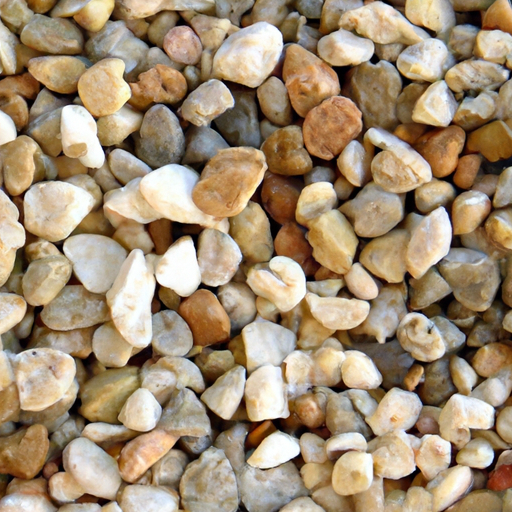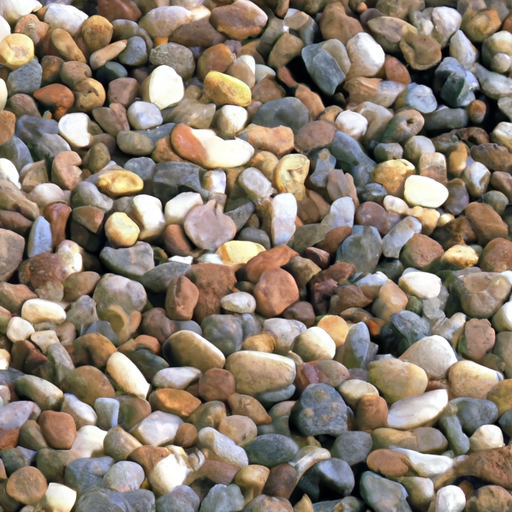
Are you looking to add a touch of elegance to your outdoor space? Choosing the right decorative gravel can be a daunting task, but fear not! This article will guide you through the process so that you can pick the perfect gravel that suits your style and enhances the beauty of your garden or landscape. Whether you prefer a rustic charm or a contemporary look, we’ve got you covered. Let’s discover how to choose decorative gravel that will transform your outdoor space into a stunning oasis.
Factors to Consider
Purpose of the Gravel
When choosing decorative gravel, it is essential to consider its purpose. Gravel can be used in various landscaping projects, driveways and pathways, mulching, and water features. Each of these purposes may require different types of gravel, so it’s crucial to determine how you plan to use it before making a decision.
Budget
Another essential factor to consider when choosing decorative gravel is your budget. By setting a budget beforehand, you can narrow down your options and avoid overspending. It’s crucial to determine the quantity of gravel you need, compare costs from different suppliers, and consider the trade-off between quality and cost.
Color and Texture
Color and texture play a significant role in the overall aesthetics of your landscaping project. Consider how the color of the gravel will harmonize with its surroundings and the overall theme you want to achieve. Additionally, think about whether you prefer a smooth or rough texture and whether you want the gravel to have a shiny or matte finish.
Size and Shape
The size and shape of the gravel are vital considerations, as they can impact both the functionality and visual appeal of the project. Certain purposes, such as driveways and pathways, may require smaller, more compact gravel for a stable and even surface. On the other hand, larger-sized gravel can provide a bold and striking visual effect in landscaping projects. Additionally, the availability of different sizes and shapes should be taken into account.
Durability and Maintenance
Considering the durability and maintenance requirements of the gravel is crucial for a long-lasting and low-maintenance project. Factors such as weather conditions and resistance to erosion should be taken into account. Additionally, think about the cleaning and maintenance efforts required to keep the gravel looking its best.
Types of Decorative Gravel
River Rock
River rock is a versatile type of decorative gravel that is commonly used in landscaping projects. It is characterized by its smooth and rounded appearance, which is created by natural water erosion. River rock is available in a variety of sizes, from small pebbles to larger stones, allowing for flexibility in design. Its neutral colors, such as shades of gray and tan, make it a popular choice for creating a natural and organic look in outdoor spaces.
Pea Gravel
Pea gravel is a type of gravel that is smaller in size, typically between 1/8 to 3/8 inches. It is named after its resemblance to the size and shape of peas. Pea gravel is often used in pathways, patios, and garden areas to create a soft and inviting look. Its smooth and rounded texture is pleasant to walk on, making it a popular choice for areas where foot traffic is expected. Pea gravel is available in various colors, including earth tones, white, and pastel shades.
Crushed Stone
Crushed stone is a popular choice for both functional and decorative purposes. It is made by crushing larger stones into smaller pieces, resulting in irregular shapes and sizes. Crushed stone is commonly used in driveways, pathways, and as a base material for other outdoor structures. It provides excellent drainage and stability. Crushed stone comes in a variety of colors, including white, gray, and earth tones, allowing for customization to match the desired aesthetic.
Lava Rock
Lava rock is a unique type of decorative gravel that originates from volcanic lava flows. It is characterized by its rough and porous texture, which gives it a distinctive appearance and feel. Lava rock comes in various sizes and colors, ranging from deep black to red and brown tones. Its natural insulation properties make it an excellent choice for water features and fire pits. However, it is important to note that lava rock can be sharp and may not be suitable for areas with heavy foot traffic.
Mexican Beach Pebbles
Mexican beach pebbles are round, smooth stones that are naturally tumbled by ocean waves. They are often imported from the beaches of Mexico and are known for their unique colors and luxurious appearance. Mexican beach pebbles come in shades of gray, black, and tan, providing a striking contrast to surrounding elements. They are commonly used in water features, pathways, and as ground cover in garden beds. However, their premium quality comes at a higher cost compared to other types of gravel.
Assessing the Purpose
Landscaping
When using decorative gravel in landscaping, consider the overall design and style you wish to achieve. River rock can be used to create a natural and serene look, while crushed stone offers a more rustic and structured appearance. Pea gravel, with its softer texture, is ideal for pathways and areas where a more casual and inviting ambiance is desired. Mexican beach pebbles can add elegance and sophistication to landscaping projects, especially when used as accents or in water features.
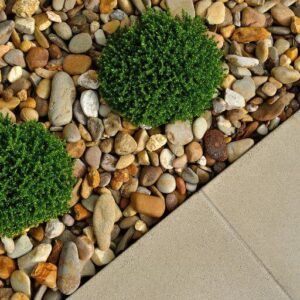
Driveways and Pathways
For driveways and pathways, durability and functionality are of utmost importance. Crushed stone is an excellent choice for these purposes, as it provides stability and excellent drainage. Its irregular shapes interlock to create a solid and even surface that can withstand heavy vehicles and foot traffic. Alternatively, pea gravel can be used for pathways, providing a softer surface while maintaining good drainage.
Mulching
When using gravel as a mulch, consider its functionality and the needs of your plants. River rock can prevent weed growth, retain moisture, and provide a decorative element to flower beds. Crushed stone is also a popular choice for mulching, as it allows for water drainage while serving as a barrier against weeds. The size and shape of the gravel should be suitable for the plant beds and easily maintainable.
Water Features
Decorative gravel can enhance the beauty of water features such as ponds, waterfalls, and fountains. Lava rock is an excellent choice for these applications, as its porous nature allows water to flow through while providing visual interest. River rock can also be used to create a natural and harmonious look around water features. Mexican beach pebbles, with their smooth and rounded appearance, can add elegance and a luxurious touch to water feature designs.
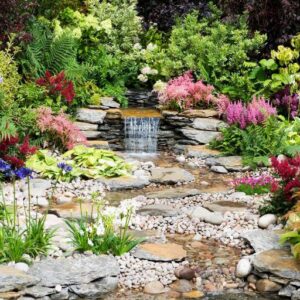
Setting a Budget
Determining the Quantity
Before setting a budget for decorative gravel, it’s crucial to determine the quantity needed for the project. Calculate the area to be covered and the desired depth of the gravel layer. This will give you an estimation of the cubic feet or pounds of gravel required. It’s recommended to overestimate slightly to account for any irregularities or changes in the project scope.
Comparing Costs
To set an accurate budget, compare costs from different suppliers and retailers. Take note of the price per cubic foot, pound, or ton of gravel. Don’t forget to factor in additional costs such as delivery fees or any required equipment or tools. Consider purchasing gravel in bulk, as it is often more cost-effective than smaller quantities. However, ensure that you have sufficient storage space to accommodate the bulk purchase.
Quality vs. Cost
When setting a budget for decorative gravel, it’s essential to strike a balance between quality and cost. While it may be tempting to choose the least expensive option, consider the long-term durability and visual appeal of the gravel. Cheaper gravel may be more prone to erosion, fading in color, or crumbling over time. Investing in higher-quality gravel may result in a more visually appealing and longer-lasting project, saving money in the long run.

Considering Color and Texture
Harmony with Surroundings
The color and texture of the gravel should harmonize with its surroundings and the existing elements in your outdoor space. Consider the colors of the surrounding plants, trees, and buildings. Neutral-colored gravel, such as shades of gray or tan, can provide a backdrop that complements various color schemes. If you want to create a sense of contrast and drama, consider using gravel in a complementary or contrasting color.
Contrast and Accents
Gravel can be used to create contrast and act as an accent in your landscaping project. For example, if you have light-colored pavers or stones, using darker gravel as a border can create visual interest. Conversely, if you have dark-colored elements, lighter gravel can provide a striking contrast. Experiment with different combinations to find the right balance between harmony and accentuation.
Smooth or Rough
Consider whether you prefer a smooth or rough texture for your gravel. Smooth river rock and Mexican beach pebbles can provide a calming and soothing tactile experience. On the other hand, rougher textures, such as crushed stone or lava rock, can add a more rugged and natural element to your project. The choice of texture will depend on your personal preference and the desired aesthetic.
Shiny or Matte
The finish of the gravel can also impact the overall aesthetics of your project. Shiny or reflective gravel, such as polished river rock or Mexican beach pebbles, can create a more contemporary and sophisticated look. Matte finishes, on the other hand, provide a more understated and natural appearance. Consider the desired ambiance and style you wish to achieve when choosing between shiny or matte gravel.
Choosing the Right Size and Shape
Purpose and Functionality
Consider the purpose and functionality of your gravel project when choosing the size and shape of the gravel. For example, if you need to create a stable surface for a driveway or pathway, smaller and compact gravel may be more suitable. Larger-sized gravel can be used to make a visual impact in landscaping projects or as a focal point in garden beds.
Personal Aesthetic
Your personal aesthetic preferences should also be considered when selecting the size and shape of the gravel. Some may prefer a more uniform and consistent look, which can be achieved with uniformly sized gravel. Others may prefer a more natural and organic look, which can be achieved by using a mixture of different sizes and shapes. Choose the option that resonates with your personal style and vision.
Availability
The availability of different sizes and shapes of gravel should also be taken into account. Not all types of gravel are available in every size or shape. Consider the local availability and accessibility of the desired gravel options. If a specific size or shape is crucial for your project, ensure that it is readily accessible or consider alternative options that meet your requirements.
Evaluating Durability and Maintenance
Weather Conditions
Consider the prevailing weather conditions in your area when evaluating the durability of the gravel. Some types of gravel, such as river rock and Mexican beach pebbles, are naturally resistant to weather elements and can withstand adverse conditions. Others, such as softer types of gravel or those prone to erosion, may require more frequent maintenance or replacement in harsh climates.
Resistance to Erosion
Erosion resistance is an essential consideration, especially for landscaping projects that are exposed to water or wind. Select gravel types that have good drainage properties and are less likely to wash away or shift during heavy rain or wind. Crushed stone and river rock, with their interlocking shapes, are often preferred for their resistance to erosion.
Cleaning and Maintenance
Another factor to consider is the cleaning and maintenance requirements of the gravel. Light-colored gravel may require more frequent cleaning to maintain its appearance, especially in areas prone to dirt or debris accumulation. Additionally, some types of gravel may need periodic redistributing or leveling to ensure an even surface. Consider the amount of time, effort, and resources you are willing to invest in maintaining the chosen gravel.
Exploring River Rock
Origin and Appearance
River rock is naturally sourced from riverbeds or water bodies where water erosion has occurred over time. This results in their smooth and rounded appearance. River rock comes in various sizes, ranging from small pebbles to larger stones, providing versatility in design. It is available in neutral colors, predominantly shades of gray and tan, but can also be found in other earth tones.
Best Uses
River rock is widely used in landscaping projects due to its versatility and natural aesthetic appeal. They can be used to create dry river beds, accentuate flower beds, line pathways or driveways, and highlight water features such as ponds or fountains. The smooth and rounded nature of river rock makes it particularly suitable for water-related applications, as it mimics the effect of naturally weathered stones.
Advantages
One of the primary advantages of river rock is its durability. The natural process of water erosion gives river rock its smooth and rounded shape, making it resistant to chipping or breaking. Additionally, river rock provides excellent drainage properties, allowing water to flow freely through the gaps between the stones. This makes it suitable for areas where proper drainage is essential, such as around water features or in garden beds.
Disadvantages
While river rock has many advantages, there are some considerations to keep in mind. The smooth surface of river rock can make it slippery when wet, so caution must be exercised in areas where foot traffic is expected. Additionally, the porous nature of river rock can make it prone to retaining moisture, leading to the growth of moss or algae. Regular cleaning and maintenance may be necessary to prevent these issues.
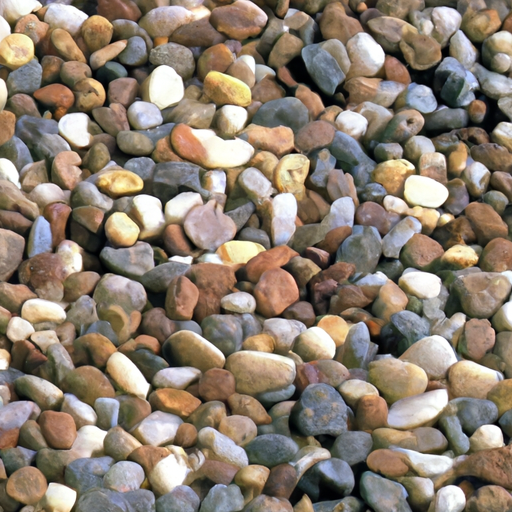
Understanding Pea Gravel
Features
Pea gravel is characterized by its small and round size, typically ranging from 1/8 to 3/8 inches. It earned its name due to its resemblance to the size and shape of peas. Pea gravel is smooth and polished, making it comfortable to walk on. It is available in various colors, including earth tones, white, and pastel shades, allowing for customization to suit different design preferences.
Suitable Applications
Pea gravel is commonly used in pathways, garden areas, and patios. Its small size and round shape make it perfect for filling spaces between larger pavers or stones, creating a soft and inviting ground cover. It can also be used as an alternative to mulch, providing a decorative element while allowing for water drainage. The smooth texture of pea gravel makes it an ideal choice for areas with light foot traffic or barefoot use.
Benefits
One of the significant benefits of pea gravel is its affordability. Due to its small size, it is often less expensive compared to larger types of decorative gravel. Additionally, the smooth and rounded nature of pea gravel makes it comfortable to walk on and safe for children and pets. It provides good drainage and prevents water from accumulating on the surface, reducing the risk of slips and falls.
Limitations
While pea gravel has many advantages, there are some limitations to consider. Being a smaller-sized gravel, it may not be suitable for areas with heavy foot traffic or for the use of outdoor furniture with thin legs, as it can shift or sink under pressure. Additionally, due to its small size, it can be easily displaced by the wind or heavy rain. Regular maintenance may be required to ensure an even distribution.
Highlighting Mexican Beach Pebbles
Unique Attributes
Mexican beach pebbles are unique decorative stones that are naturally tumbled by ocean waves. They are sourced from the beaches of Mexico and have distinct characteristics that set them apart from other types of gravel. Mexican beach pebbles are known for their smooth and rounded shapes, achieved through years of natural weathering. They come in various colors, including shades of gray, black, and tan, with each stone having a unique blend of colors.
Recommended Uses
Mexican beach pebbles are highly versatile and can be used in various landscaping projects. They are commonly used in water features, such as ponds or fountains, to create a natural and tranquil ambiance. Mexican beach pebbles can also be used to line walkways or pathways, providing a visually appealing and distinct surface. They are often used as an accent or focal point in garden beds, adding texture and contrast to the surrounding plants.
Pros
One of the main advantages of Mexican beach pebbles is their natural beauty and luxurious appearance. Their smooth and rounded texture, combined with their unique colors, adds a touch of elegance and sophistication to any outdoor space. Mexican beach pebbles are also highly durable and resistant to weathering, ensuring their longevity. Additionally, they do not require regular maintenance or cleaning, making them a low-maintenance option.
Cons
One important consideration regarding Mexican beach pebbles is their higher cost compared to other types of decorative gravel. Their uniqueness and limited availability contribute to their premium pricing. Furthermore, due to their smooth and rounded nature, Mexican beach pebbles can be challenging to walk on or may become slippery when wet. Caution must be exercised in areas where foot traffic is expected to prevent any accidents.
